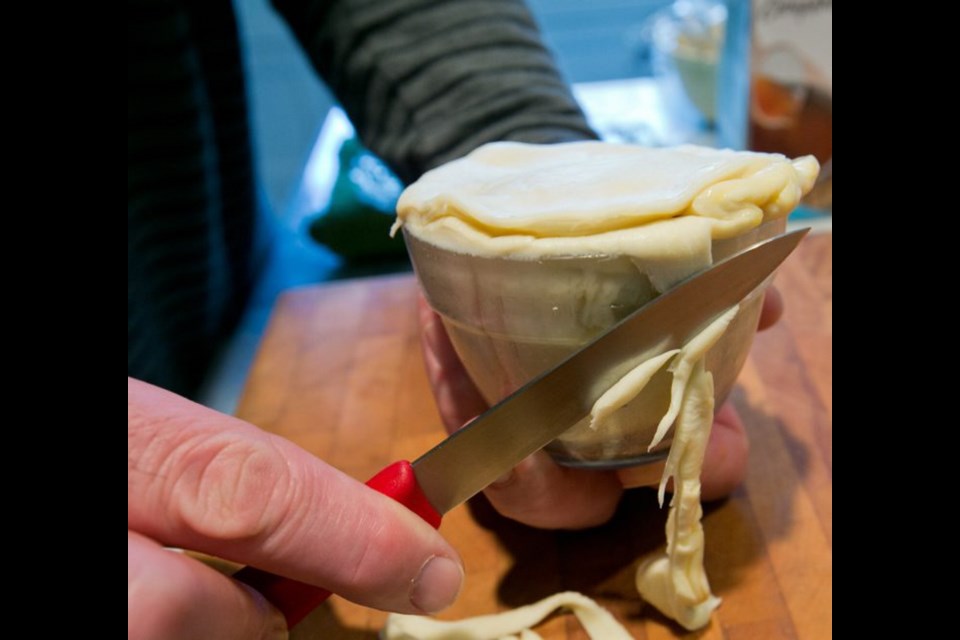 Dear Eric: I read your article: “How to replace suet in a Christmas pudding.” I’m an English lady living abroad. My job is making pies and pasties for hotels and restaurants. I live in Turkey and it’s impossible to buy suet here, but this year I wanted to make steak puddings. Have you any recipes for savoury puddings without suet?
Dear Eric: I read your article: “How to replace suet in a Christmas pudding.” I’m an English lady living abroad. My job is making pies and pasties for hotels and restaurants. I live in Turkey and it’s impossible to buy suet here, but this year I wanted to make steak puddings. Have you any recipes for savoury puddings without suet?
Deborah Burley
��
Dear Deborah: The article you cite was published October 2012. It answered a reader’s question about making Christmas pudding without the suet that’s used in most traditional recipes.
The column is still available online and Deborah saw it there. The last time I checked, hard copies of the Times 91ԭ�� were not being delivered to Turkey.
Suet is a solid white fat found around the kidneys and loins of bovines and other animals. It’s used in Christmas puddings because of its rich taste and moisture. It also has a high melting point so, during the many hours of steaming required to cook the pudding, the suet will melt slowly and stay inside it, not melt quickly and seep out.
The steak puddings Deborah mentions, such as steak and kidney pudding, are also steamed for a long time, particular large, family-sized ones. A suet pastry traditionally encases the filling because, as with the Christmas pudding, it will add flavour and moisture and will melt slowly, ensuring it stays in the pastry.
But suet isn’t available in Turkey; in fact, it’s not easy to find in Victoria. In a second email, Deborah said that she wants to make single-serving puddings. They would be much smaller than a family-sized version and therefore the pastry would cook and set much more quickly.
That allowed me to try using other types of fat in the pastry. I had success using a mix of butter and lard, which I’m guessing Deborah will find in Turkey.
My recipe is flexible; if you want to make just steak pudding, simply replace the kidneys with more stewing beef. To make stout-flavoured puddings, replace half of the stock with a dark beer, such as Guinness.
Individual Oven-Steamed Steak and Kidney Puddings
These littl epuddings are steamed in small heatproof cups sold at stores offering a good range of kitchenware. Make a hearty lunch or supper by serving the puddings with mashed potatoes and some vegetables of your choice. You could also top it with homemade gravy, or serve it with mustard pickles.
Preparation time: 45 minutes
Cooking time: Three hours
Makes: Four servings
For pudding filling
3 Tbsp all-purpose flour (see note)
• salt and freshly ground black pepper, to taste
1 lb stewing beef, cut into 3/4-inch pieces
1/2 lb lamb or beef kidneys, trimmed of any sinew or fat, cut into 3/4-inch pieces
2 Tbsp olive or vegetable oil
2 Tbsp butter
1 medium onion, diced
1/4 lb small white mushrooms (about 8 to 10), halved and sliced
1 1/4 cups beef stock or broth (see Note)
1 Tbsp Worcestershire sauce
1/2 tsp dry mustard powder
• pinch dried thyme
1 Tbsp chopped fresh parsley
��
Preheat the oven to 300 F. Place the flour in a medium to large bowl and season with salt and pepper. Add the beef and kidneys and toss to coat.
Place the oil and butter in a Dutch oven or other ovenproof pot set over medium-high heat. When the butter has melted, working in batches, sear the pieces of beef and kidney until nicely browned. Transfer the cooked pieces to a plate as you go along.
When the beef and kidney have been browned, add the onion and mushrooms to the pot and cook until tender, about five minutes. Stir in the stock, Worcestershire sauce, mustard and thyme. Return the beef and kidneys to the pot and bring to a simmer.
Cover the pot, set in the oven and cook 90 minutes, or until the beef is tender. Taste the mixture and season with salt and pepper, if needed. Cool the filling to room temperature. Mix the parsley into the filling, transfer to a refrigerator-friendly vessel, cover and refrigerate until ready to fill the puddings. You should end up with about 4��cups of filling. Pudding filling can be made a day before needed.
For the pudding pastry and��to��finish
3 cups all-purpose flour (see Note)
2 tsp baking powder (see Note)
1/2 tsp dry mustard powder
1 tsp salt
1/4 cup very cold butter, cut into tiny cubes
1/4 cup very cold pure lard, cut into tiny cubes
1 cup plus 2 Tbsp cold water
1 large egg, beaten
Vegetable oil spray
Combine the flour, baking powder, mustard and salt in the bowl of your stand mixer fitted with the paddle attachment. Add the butter and lard and mix until well-blended and only small specks of both appear.
Add the water and mix until a loose dough forms. Transfer the dough to a lightly floured work surface. With lightly floured hands, shape the dough into a ball. Press the dough into a 2.5-cm-thick disc. Wrap, rest and refrigerate the dough at least 30 minutes, or until ready to make the puddings.
When ready to make the puddings, grease the inside of four, one-cup glass or ceramic baking cups with vegetable oil spray. (My cups were nine centimetres wide and six cm tall.)
Unwrap the dough and set on a large, lightly floured work surface. With a lightly floured rolling pin, roll the dough into a 56-centimetre square, about a third of a centimetre thick. Cut the dough into four, 20-centimetre rounds. If the dough shrinks back after cutting, roll each round out a bit until it’s 20-cm round again.
Preheat the oven to 350 F. Nestle a round of dough into each baking cup, trying not to stretch it and ensuring some of it drapes over the rim of the cup (see photo).
Spoon filling into each cup. Brush the top of the dough draping over the rim of cups with beaten egg.
Cut the remaining dough into four, 10-cm rounds. Set one on top of each pudding, pressing it into place. Trim excess dough around the rim of each cup (see Note).
Cover the top of each pudding with a double-thickness of aluminum foil, tightly crimping it around each cup and doming it slightly on top to allow the pudding to expand.
Set the puddings in a 23- by-33-cm baking dish. Add enough hot water to baking dish until it comes halfway up the sides of each cup.
Tightly cover the whole baking dish with aluminum foil. Oven-steam the puddings for 75 minutes, or until slightly puffed and the pastry is cooked. You can unmould, plate and serve the hot puddings at once.
Or you could cool the puddings to room temperature, leaving them in their baking cups. At this point you can wrap and refrigerate the puddings until ready to reheat, unmould and serve in the next day or two. The puddings can be reheated a few minutes in the microwave, using short 30 seconds spurts of heat so they don’t burst. You can also reheat them by setting the cups on a baking sheet and heating in a 350 F oven for about 30 minutes, or until hot throughout.
After steaming and cooling, these puddings could also be frozen for up to two months. Thaw in the fridge overnight before reheating as described above.
��
Note: 3 cups plus 2 tsp of self-raising flour could replace the all-purpose four and baking powder called for in this recipe.
Note: Leftover dough trimmings can be gathered into a ball, flattened into a disc, wrapped and frozen for another use, such as for topping potpies.
Eric Akis is the author of The Great Rotisserie Chicken Cookbook (Appetite by Random House). It will be released Tuesday. His columns appear in the Life section Wednesday and Sunday.



